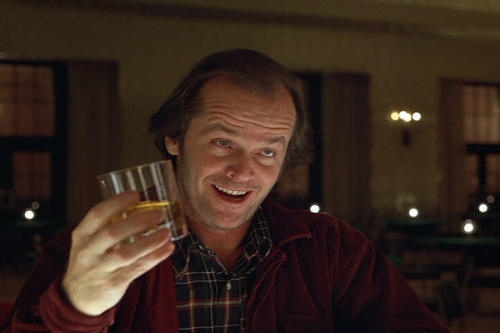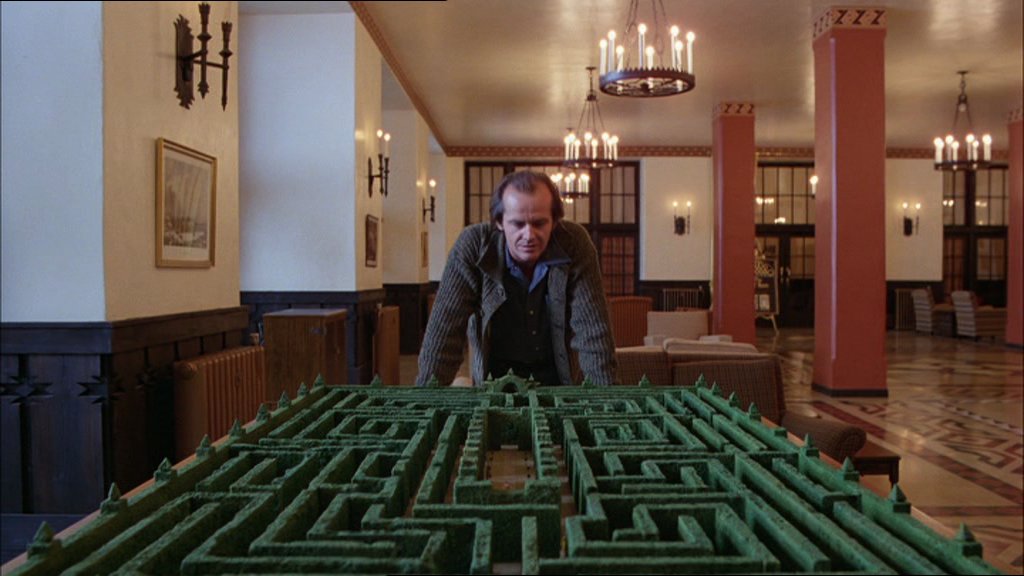Within the shining I will be analysing the Bar scene. The scene opens with a long shot of Jack Nicholson in a hallway, the scene is filled with gaudy colours which contrasts with Jack's rather dull outfit. There is low-key lighting, which contrast with the three large chandeliers, it could foreshadow that this is a dark place; with each step the camera closes in closer and closer, as more of the background becomes out of shot it makes the scene claustrophobic. The aural effects build up, it starts with an extreme high pitch a common convention of horror films; horror films use extreme music to create tension and make you feel claustrophobic. The personal effect of the opening scene on me, is that it builds tension, the long tracking back shot builds tension; Nicholson's performance, his spur of the moment throwing of arms and his grunting keep you on the edge. Because of the way he is acting, I expect him to do something potentially dangerous, so the arrival into the bar is a bit of an anti-climax.
After this we see a shot of Jack walking into the big bar, the room is black and he walks through half the open door, the other door is closed. This could symbolise Jack's walk into the dark side, and to insanity; he enters the bar obviously looking for a drink something that wouldn't help his current mental position. When he enters the bar the camera tracks him right, and we see him walking across a large empty dining hall, this isn't the first time we see Jack in a room that would usually be full and is in fact empty, it shows that he is alone and he is lacking human contact despite the fact that his family is staying at the hotel with him. Most of the time we see Jack he is in a large setting, that would usually be full of people e.g the hotel lobby but he is always alone which could foreshadow his mental state.

Our first indication of him seeing ghosts is when we see him take a seat at the empty bar, and again we see his reflection in the mirror; mirrors are used to show that you think your seeing Jack but your just seeing the reflection of Jack. Shot reverse shot is used to show Jack's reaction to seeing the bartender there and a full bar. This is the first time we see anyone interacting with ghosts other than Danny. You know that it's a ghost because the bar went from empty to full, and ghosts are seen at other times in this film. The bar tender is wearing red, an alarming colour the bartender also to me looks slightly shifty, like there's something not right. I know that he isn't real, yet he still serves Jack with no charge; perhaps his sanity was the price. In fact Jack says " I would give my god-damn soul for.. just a glass of beer" red is also a colour associated with hell, the devil; Jack's choice of words and the fact that he doesn't get charged indicate that that's perhaps what he did.
The second scene I will be analysing is the first maze scene. The scene uses parallel editing, I assume that Jack is watching over Danny and Wendy, in the exact place that they are in. The use of parallel editing shows that Jack has the power of Danny and Wendy he knows more about the ghosts and previous events in the house. Also it shows the power Danny holds over his family, it made me fear for Danny and Wendy, it was like God looking down on Earth manipulating everything that happens showing that he has the upper hand. It also foreshadows later event's Danny hunting them down in the maze and attempting to kill them and being a predator watching his prey, Also the maze is a like a playground a place they went to have fun, it could show that they are like pawns in Jack's game.

In this scene we also see Wendy find out what Jack has been writing. The aural effects start off being slightly quieter we see Wendy scrolling down, the shot of the typewriter and the fact the camera is still whilst the typewriter continues on with "All work and no play makes Jack a dull boy" it makes it seem never ending. The shot reverse shot to show Wendy's reaction to this. The camera looks like the point of view is from the type writer, and to me it seems like it is waiting for her to look, Wendy comes into the frame and it looks like she is looking down at the writing it builds up tension because the audience doesn't know what he's been writing either. The music seems to build up along with the tension making the scene more claustrophobic; We are anxious to see what he's been writing but also scared because we know about Jack's mental state and have no idea what he could have wrote.
After showing Wendy's reaction to the typewriter, it shows an overhead shot of the work in the paper filer, the shot stays still and is fixed all we see is Wendy's hand tearing the sheets up, with every grab it gets more frantic and the music seems to sound more atonal and more instruments seem to be thrown in, making it sound like clutter and because of the fixed shot when all you can see is the sheets of paper makes it feel very claustrophobic. With every new sheet it seems to take a new format on the paper, yet it says the same thing; it could be a representation of Jack's mental state his mind is all over the place but he is still thinking of. This is also a reference to other media such as " The Bridge on the River Kwai" the phrase means that whilst he keeps working he becomes boring. This is the confirmation that Jack is crazy for Wendy; making the scene pivotal.











 Towards the end of the film we make a revelation, that in fact Grace's house is not haunted, we discover she was a psychopath who murdered both of her children, and their dead spirits live on in the house and the only ghosts within the house are her and her children and the staff that live with her.
Towards the end of the film we make a revelation, that in fact Grace's house is not haunted, we discover she was a psychopath who murdered both of her children, and their dead spirits live on in the house and the only ghosts within the house are her and her children and the staff that live with her.